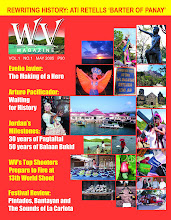 We are back!
We are back!By: Dr. Ruben Z. Martinez
Effort to reconstruct the cultural history of Antique is indeed a heroic act. Reconstructing cultural history requires piecing together bits and pieces of information from various sources. In the absence of systematic archaeological investigation to enable us to put together a cultural chronology or reconstruct the life ways of the earlier inhabitants, we can resort to ethnographic inference and analogy to possibly shed light on the customs and traditions of the indigenous Ati, and also on the so called “Barter of Panay.”
Negrito groups, such as the Ati, as they themselves recollect, are nomadic hunters and gatherers. However, as their hunting grounds became smaller as a result of population pressure and logging activities, they broaden their livelihood activities to include agriculture.
The Ati, - unlike other groups with longer tradition of horticulture and later intensive agriculture – failed to develop the associated material culture that are normally found in horticultural and agricultural societies. In most cases, these also have tradition of pottery and weaving. Pottery is an important component in the development of rice culture.
The presence or absence of this diagnostic cultural artifact provides clues on the kind of culture and cultural configuration of a particular group. Ati as hunters and gatherers is primarily an egalitarian society. It can be surmised that their leadership pattern is based on age and sex.
The indigenous Ati inhabiting the coastal and forest areas of Panay prior to the migration of the Bornean Datus may have a property concept similar to other hunting and gathering societies in the Philippines. Unlike the horticulturalist or agriculturalist, they do not regard land as a private property.
Even among the Hanunoo of Southern Mindoro or the Iraya of Northern Mindoro, who have longer tradition of horticulture and shifting agriculture, it was only in the later date when they developed the concept of private ownership of land.
Prior to contact with the Spanish and American colonizers, Hanunoo and Iraya, regard land as sacred and stewardship of the land is passed on to them be their ancestors, who continue to reside in their land. Kalag and Bukaw (Spirits) are part of their landscape, this is similar to the indigenous belief on mariit (sacred place).
Possession of land among Hanunoo and Iraya is based on use rights, they retain stewardship of the land for as long as they cultivate the land. The land reverts to communal use once the original vegetation is restored or they abandon the swidden plot during its fallow period (rest period).
There is a high probability therefore that the so called barter of Panay did not happen. Assuming that the Bornean Datu gave the welcoming Ati gifts, it is unlikely that the Ati have exchanged their land for the said gifts. It would be erroneous to assume that the Ati would have the same concept of land as the seafaring Bornean Datus or to use our current property concept which treats land as a real property that can be transferred or sold.
The challenge for historians, archaeologists and ethnographers is to unearth facts and information about the ancient life ways.
This is not only about reconstructing the drama of exchanging gifts but also to reconstruct their life ways, piece together part of our local history and cultural chronology, and most importantly draw lessons and insights from the past.



1 comment:
I agree with you that in order to fully reconstruct our respective cultures, it is important to find substantial artifact that would shed hard evidence on the existence or non-existence of civilizations. I hope that you are closely working with tatang bong dizon, the head of the National Museum Archeology Department. He is a Kapampangan from Mabalacat. he is also helping us here look for artifact to prove that the Kapampangan settlements were already advanced in the 12th century, hundreds of years before the Spaniards came. The center of trade were believed to be seen in the riverbanks of Porac, Candaba and Lubao.
--MINI ZAMORA ARCEO
Post a Comment